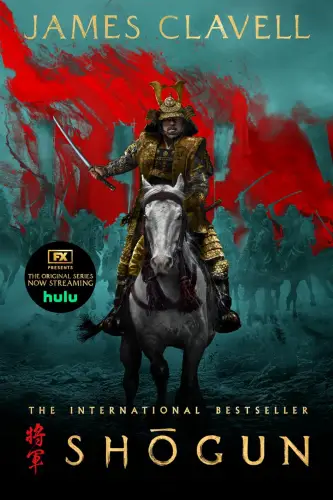Shōgun by James Clavell
Book Author: James Clavell
Summary reviewed by:
Terrence Timmons
Terrence Timmons
Analyst
Bachelor of Arts (BA), University Of California, Santa Barbara 2019
With over 4 years of experience as an analyst. Terrence Timmons is committed to analyzing summaries without compromising on quality.
Shōgun by James Clavell: Summary
Set in the tumultuous landscape of early 17th-century Japan, "Shōgun" stands as the monumental first entry in James Clavell's acclaimed Asian Saga.
Imagine being thrust into a foreign land where every step could mean life or death. "Shōgun" immerses readers in the captivating journey of John Blackthorne, an English navigator whose ship wrecks on the shores of feudal Japan. As the first novel in Clavell's Asian Saga, this epic tale unfolds against the backdrop of political intrigue, cultural clashes, and personal transformation.
Blackthorne, the pilot of the Dutch ship Erasmus, finds himself stranded in a society governed by strict codes of honor and power. Initially perceived as an outsider and a potential threat, his survival hinges on his ability to navigate the complexities of Japanese customs and the volatile dynamics of samurai warfare. Under the watchful eye of Lord Toranaga, a powerful daimyo with aspirations of becoming Shōgun, Blackthorne becomes an invaluable asset in the quest for dominance.
Throughout the narrative, Clavell masterfully weaves themes of loyalty, ambition, and adaptation. Blackthorne's journey is not just a physical survival but also an exploration of identity as he learns the language, embraces local traditions, and gains the respect of those around him. The intricate relationships between characters highlight the delicate balance of power, as alliances are formed and broken in the relentless pursuit of authority.
"Shōgun" is a vivid portrayal of a pivotal moment in Japanese history, offering readers a window into the samurai ethos, the art of strategy, and the profound cultural differences that define the era. Clavell's meticulous research and immersive storytelling bring to life the sights, sounds, and emotions of a society on the brink of transformation. Whether you're a history enthusiast or a lover of richly detailed narratives, "Shōgun" promises an unforgettable adventure that transcends time and geography.
Spoilers (watch a short ad to reveal spoilers)
Shōgun by James Clavell: Genres
Historical fiction
Adventure
Epic
Political thriller
Survival
Shōgun by James Clavell: Main Characters
John Blackthorne: An intrepid English navigator whose resilience and adaptability enable him to survive and thrive in the unfamiliar and often hostile environment of feudal Japan. His willingness to learn and respect Japanese customs earns him trust and respect among the locals.
Lord Toranaga: A shrewd and strategic daimyo with ambitions of becoming Shōgun. His intelligence and cunning in political maneuvering demonstrate his unwavering dedication to achieving power and stability for his domain.
Mariko: A skilled and intelligent samurai woman who serves as Toranaga’s translator and advisor. Her loyalty and grace under pressure highlight her strong sense of duty and honor, bridging the gap between Blackthorne and Japanese society.
Ishido: Toranaga’s rival, whose manipulative and power-hungry nature poses a constant threat to Toranaga’s plans. His relentless pursuit of dominance showcases his strategic mind and ruthless tactics.
Omi: A samurai loyal to Toranaga, whose bravery and unwavering support play a crucial role in the unfolding political landscape. His commitment exemplifies the samurai code of loyalty and honor.
Yabu: A powerful and ambitious daimyo who initially opposes Toranaga. His shifting alliances and tactical decisions illustrate the volatile nature of power dynamics in feudal Japan.
Shōgun by James Clavell: Themes
Cultural Clash and Adaptation: The novel delves into the complexities of navigating vastly different cultural landscapes, highlighting Blackthorne’s transformation as he adopts Japanese customs and integrates into society.
Power and Ambition: The relentless pursuit of power drives the characters’ actions, illustrating the intricate strategies and sacrifices made in the quest for dominance and authority.
Loyalty and Honor: The samurai code of honor plays a central role, emphasizing the importance of loyalty to one’s lord and the ethical dilemmas faced by characters in their quest for power.
Identity and Transformation: Blackthorne’s journey reflects a profound exploration of identity as he evolves from an outsider to a respected figure within Japanese society, questioning his loyalties and sense of self.
Strategic Warfare and Diplomacy: The interplay of military tactics and diplomatic maneuvering underscores the delicate balance required to navigate the political landscape of feudal Japan.
East Meets West: The blending of Eastern and Western philosophies and practices highlights the transformative impact of cross-cultural interactions and the potential for mutual growth and understanding.
Shōgun by James Clavell: What You Need to Know
(Contains Spoilers: Perfect for readers seeking a quick review.)
"Shōgun" intricately weaves a tale of survival, ambition, and cultural immersion set against the rich tapestry of early 17th-century Japan. The story begins with the ship Erasmus, carrying John Blackthorne and his crew, being wrecked on the shores of Japan. Blackthorne, an experienced navigator, finds himself in a land governed by rigid social hierarchies and complex honor codes, vastly different from his European origins.
Upon his arrival, Blackthorne is initially seen as an outsider and a potential threat by the Japanese authorities. His advanced knowledge of navigation and European technology quickly draws the attention of Lord Toranaga, a cunning and ambitious daimyo striving to become Shōgun. Recognizing Blackthorne's value, Toranaga takes him under his wing, seeking to leverage his maritime expertise to strengthen his own political and military strategies.
As Blackthorne acclimates to Japanese society, he learns the language, customs, and intricate social norms that dictate daily life and governance. His relationship with Mariko, a respected samurai woman, becomes pivotal, providing him with guidance and facilitating his deeper integration into the culture. Mariko's intelligence and grace help bridge the gap between Blackthorne and the Japanese elite, fostering mutual respect and understanding.
Toranaga's quest for power is marked by strategic alliances and calculated moves to undermine his rival, Ishido. The tension between Toranaga and Ishido escalates as both vie for control, leading to a series of political maneuvers and confrontations. Blackthorne's insights and innovative approaches to warfare and diplomacy play a crucial role in Toranaga's strategies, blending Western techniques with traditional samurai tactics.
Throughout the narrative, the delicate balance of power is maintained through shifting alliances and the ever-present threat of betrayal. Characters such as Yabu and Omi navigate these turbulent waters, their actions driven by personal ambition, loyalty, and the overarching goal of securing their lord's position. The intricate web of relationships and the constant interplay of honor and pragmatism add depth to the political landscape depicted in the novel.
As tensions reach a boiling point, Toranaga orchestrates a decisive series of events that culminate in his ultimate triumph over Ishido. The final confrontation not only secures Toranaga's position as Shōgun but also signifies a transformative period in Japanese history. Blackthorne, having fully embraced his new life, faces the profound choice of remaining in Japan or returning to his homeland, symbolizing the enduring impact of his journey and the cultural synthesis that has occurred.
The novel concludes with Toranaga's victory, establishing a new order and setting the stage for future developments within the Asian Saga. Blackthorne's integration into Japanese society and his partnership with Toranaga exemplify the potential for cross-cultural collaboration and the enduring legacy of their alliance. "Shōgun" leaves readers with a rich understanding of the complexities of power, loyalty, and identity, encapsulating the essence of an epic historical saga.
Shōgun by James Clavell: Methodology
Drawing deeply from the rich themes of cultural clash and power dynamics, our expert team delved into every nuance of "Shōgun." By meticulously synthesizing key elements and pivotal moments, we captured the essence of John Blackthorne's transformative journey and Lord Toranaga's strategic maneuvers. Upholding the highest standards of quality and integrity, we ensured that each detail resonates with authenticity, offering readers a faithful and engaging glimpse into Clavell's epic narrative. This thoughtful approach guarantees a summary that not only informs but also immerses you in the heart of feudal Japan.


Shōgun by James Clavell
Date Published: 1975
Disclaimer: As an Amazon Associate I earn from qualifying purchases.




